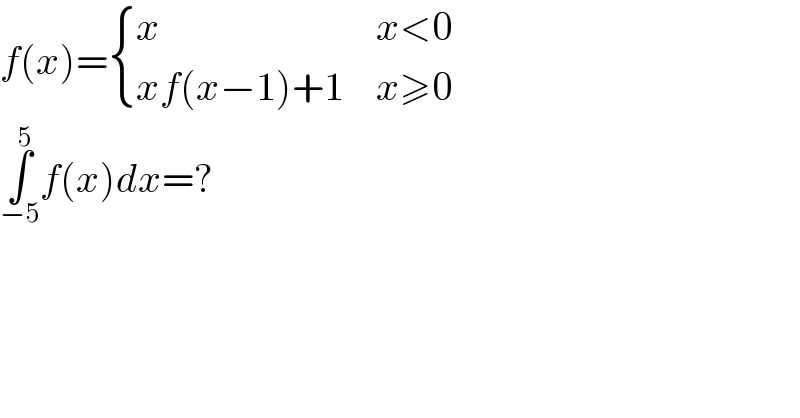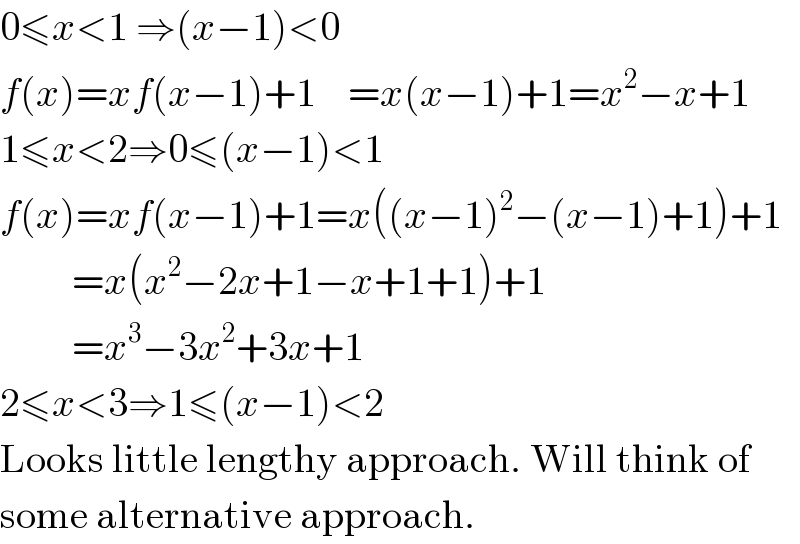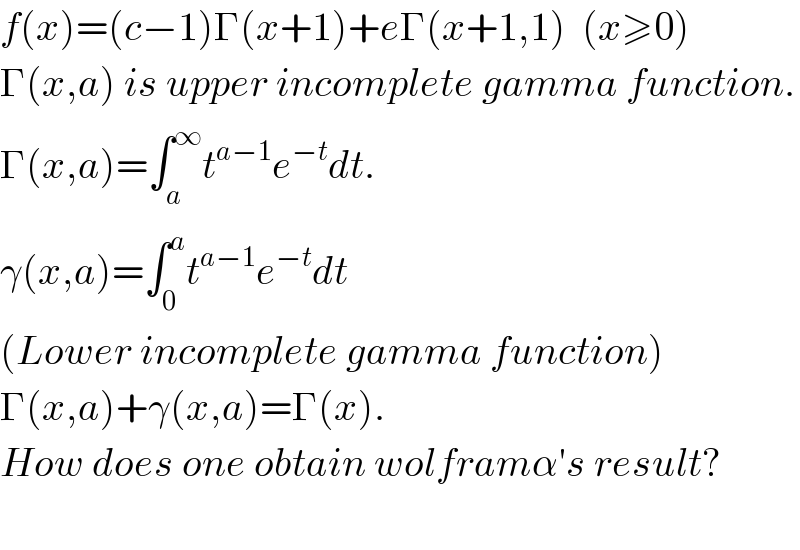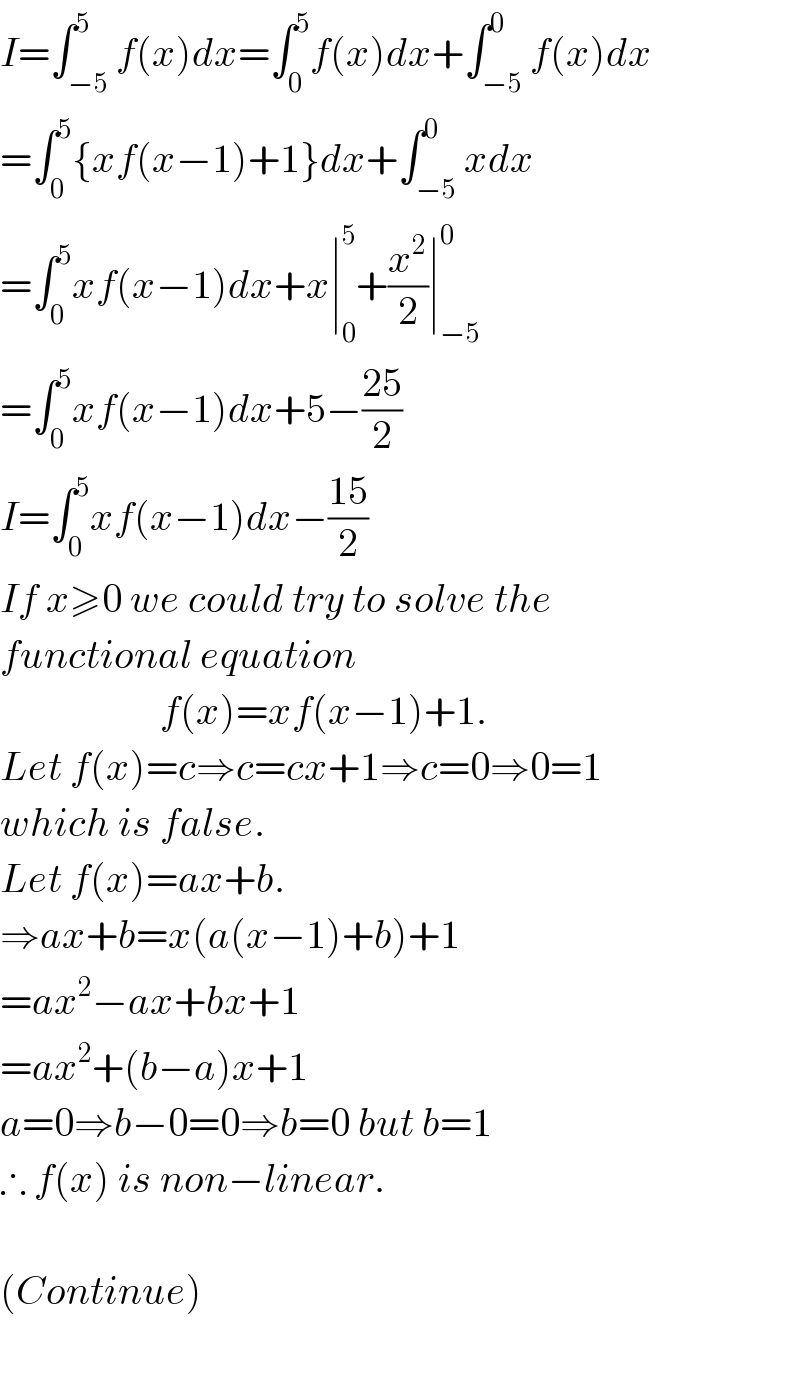
Question Number 4883 by 123456 last updated on 19/Mar/16

$${f}\left({x}\right)=\begin{cases}{{x}}&{{x}<\mathrm{0}}\\{{xf}\left({x}−\mathrm{1}\right)+\mathrm{1}}&{{x}\geqslant\mathrm{0}}\end{cases} \\ $$ $$\underset{−\mathrm{5}} {\overset{\mathrm{5}} {\int}}{f}\left({x}\right){dx}=? \\ $$
Commented byprakash jain last updated on 19/Mar/16

$$\mathrm{0}\leqslant{x}<\mathrm{1}\:\Rightarrow\left({x}−\mathrm{1}\right)<\mathrm{0} \\ $$ $${f}\left({x}\right)={xf}\left({x}−\mathrm{1}\right)+\mathrm{1}\:\:\:\:={x}\left({x}−\mathrm{1}\right)+\mathrm{1}={x}^{\mathrm{2}} −{x}+\mathrm{1} \\ $$ $$\mathrm{1}\leqslant{x}<\mathrm{2}\Rightarrow\mathrm{0}\leqslant\left({x}−\mathrm{1}\right)<\mathrm{1} \\ $$ $${f}\left({x}\right)={xf}\left({x}−\mathrm{1}\right)+\mathrm{1}={x}\left(\left({x}−\mathrm{1}\right)^{\mathrm{2}} −\left({x}−\mathrm{1}\right)+\mathrm{1}\right)+\mathrm{1} \\ $$ $$\:\:\:\:\:\:\:\:\:={x}\left({x}^{\mathrm{2}} −\mathrm{2}{x}+\mathrm{1}−{x}+\mathrm{1}+\mathrm{1}\right)+\mathrm{1} \\ $$ $$\:\:\:\:\:\:\:\:\:={x}^{\mathrm{3}} −\mathrm{3}{x}^{\mathrm{2}} +\mathrm{3}{x}+\mathrm{1} \\ $$ $$\mathrm{2}\leqslant{x}<\mathrm{3}\Rightarrow\mathrm{1}\leqslant\left({x}−\mathrm{1}\right)<\mathrm{2} \\ $$ $$\mathrm{Looks}\:\mathrm{little}\:\mathrm{lengthy}\:\mathrm{approach}.\:\mathrm{Will}\:\mathrm{think}\:\mathrm{of} \\ $$ $$\mathrm{some}\:\mathrm{alternative}\:\mathrm{approach}. \\ $$
Commented byprakash jain last updated on 19/Mar/16
![0≤x<1⇒(x−1)<0 f(x)=xf(x−1)+1=x(x−1)+1 1≤x<2⇒0≤(x−1)<1 f(x)=xf(x−1)+1=x[(x−1)(x−2)+1]+1 =x(x−1)(x−2)+x+1 2≤x<3⇒1≤(x−1)<2 f(x)=xf(x−1)+1=x[(x−1)(x−2)(x−3)+(x−1)+1]+1 =x(x−1)(x−2)(x−3)+x^2 +1 3≤x<4⇒2≤x<3 f(x)=xf(x−1)+1 =x[(x−1)(x−2)(x−3)(x−4)+(x−1)^2 +1]+1 =x(x−1)(x−2)(x−3)(x−4)+x(x−1)^2 +x+1 4≤x<5⇒3≤x<4 f(x)=xf(x−1)+1 =x[(x−1)(x−2)(x−3)(x−4)(x−5)+(x−1)(x−2)^2 +x]+1 =x(x−1)(x−2)(x−3)(x−4)(x−5)+x(x−1)(x−2)^2 +x^2 +1 To be continued for integration.](Q4888.png)
$$\mathrm{0}\leqslant{x}<\mathrm{1}\Rightarrow\left({x}−\mathrm{1}\right)<\mathrm{0} \\ $$ $${f}\left({x}\right)={xf}\left({x}−\mathrm{1}\right)+\mathrm{1}={x}\left({x}−\mathrm{1}\right)+\mathrm{1} \\ $$ $$\mathrm{1}\leqslant{x}<\mathrm{2}\Rightarrow\mathrm{0}\leqslant\left({x}−\mathrm{1}\right)<\mathrm{1} \\ $$ $${f}\left({x}\right)={xf}\left({x}−\mathrm{1}\right)+\mathrm{1}={x}\left[\left({x}−\mathrm{1}\right)\left({x}−\mathrm{2}\right)+\mathrm{1}\right]+\mathrm{1} \\ $$ $$\:\:\:\:\:\:\:\:\:={x}\left({x}−\mathrm{1}\right)\left({x}−\mathrm{2}\right)+{x}+\mathrm{1} \\ $$ $$\mathrm{2}\leqslant{x}<\mathrm{3}\Rightarrow\mathrm{1}\leqslant\left({x}−\mathrm{1}\right)<\mathrm{2} \\ $$ $${f}\left({x}\right)={xf}\left({x}−\mathrm{1}\right)+\mathrm{1}={x}\left[\left({x}−\mathrm{1}\right)\left({x}−\mathrm{2}\right)\left({x}−\mathrm{3}\right)+\left({x}−\mathrm{1}\right)+\mathrm{1}\right]+\mathrm{1} \\ $$ $$\:\:\:\:\:\:\:\:\:={x}\left({x}−\mathrm{1}\right)\left({x}−\mathrm{2}\right)\left({x}−\mathrm{3}\right)+{x}^{\mathrm{2}} +\mathrm{1} \\ $$ $$\mathrm{3}\leqslant{x}<\mathrm{4}\Rightarrow\mathrm{2}\leqslant{x}<\mathrm{3} \\ $$ $${f}\left({x}\right)={xf}\left({x}−\mathrm{1}\right)+\mathrm{1} \\ $$ $$\:\:\:\:\:\:\:\:\:={x}\left[\left({x}−\mathrm{1}\right)\left({x}−\mathrm{2}\right)\left({x}−\mathrm{3}\right)\left({x}−\mathrm{4}\right)+\left({x}−\mathrm{1}\right)^{\mathrm{2}} +\mathrm{1}\right]+\mathrm{1} \\ $$ $$\:\:\:\:\:\:\:\:\:={x}\left({x}−\mathrm{1}\right)\left({x}−\mathrm{2}\right)\left({x}−\mathrm{3}\right)\left({x}−\mathrm{4}\right)+{x}\left({x}−\mathrm{1}\right)^{\mathrm{2}} +{x}+\mathrm{1} \\ $$ $$\mathrm{4}\leqslant{x}<\mathrm{5}\Rightarrow\mathrm{3}\leqslant{x}<\mathrm{4} \\ $$ $${f}\left({x}\right)={xf}\left({x}−\mathrm{1}\right)+\mathrm{1} \\ $$ $$={x}\left[\left({x}−\mathrm{1}\right)\left({x}−\mathrm{2}\right)\left({x}−\mathrm{3}\right)\left({x}−\mathrm{4}\right)\left({x}−\mathrm{5}\right)+\left({x}−\mathrm{1}\right)\left({x}−\mathrm{2}\right)^{\mathrm{2}} +{x}\right]+\mathrm{1} \\ $$ $$={x}\left({x}−\mathrm{1}\right)\left({x}−\mathrm{2}\right)\left({x}−\mathrm{3}\right)\left({x}−\mathrm{4}\right)\left({x}−\mathrm{5}\right)+{x}\left({x}−\mathrm{1}\right)\left({x}−\mathrm{2}\right)^{\mathrm{2}} +{x}^{\mathrm{2}} +\mathrm{1} \\ $$ $$\mathrm{To}\:\mathrm{be}\:\mathrm{continued}\:\mathrm{for}\:\mathrm{integration}. \\ $$
Commented byYozzii last updated on 21/Mar/16

$${f}\left({x}\right)=\left({c}−\mathrm{1}\right)\Gamma\left({x}+\mathrm{1}\right)+{e}\Gamma\left({x}+\mathrm{1},\mathrm{1}\right)\:\:\left({x}\geqslant\mathrm{0}\right) \\ $$ $$\Gamma\left({x},{a}\right)\:{is}\:{upper}\:{incomplete}\:{gamma}\:{function}. \\ $$ $$\Gamma\left({x},{a}\right)=\int_{{a}} ^{\infty} {t}^{{a}−\mathrm{1}} {e}^{−{t}} {dt}. \\ $$ $$\gamma\left({x},{a}\right)=\int_{\mathrm{0}} ^{{a}} {t}^{{a}−\mathrm{1}} {e}^{−{t}} {dt}\:\: \\ $$ $$\left({Lower}\:{incomplete}\:{gamma}\:{function}\right) \\ $$ $$\Gamma\left({x},{a}\right)+\gamma\left({x},{a}\right)=\Gamma\left({x}\right). \\ $$ $${How}\:{does}\:{one}\:{obtain}\:{wolfram}\alpha'{s}\:{result}? \\ $$ $$ \\ $$
Answered by Yozzii last updated on 19/Mar/16

$${I}=\int_{−\mathrm{5}} ^{\mathrm{5}} {f}\left({x}\right){dx}=\int_{\mathrm{0}} ^{\mathrm{5}} {f}\left({x}\right){dx}+\int_{−\mathrm{5}} ^{\mathrm{0}} {f}\left({x}\right){dx} \\ $$ $$=\int_{\mathrm{0}} ^{\mathrm{5}} \left\{{xf}\left({x}−\mathrm{1}\right)+\mathrm{1}\right\}{dx}+\int_{−\mathrm{5}} ^{\mathrm{0}} {xdx} \\ $$ $$=\int_{\mathrm{0}} ^{\mathrm{5}} {xf}\left({x}−\mathrm{1}\right){dx}+{x}\mid_{\mathrm{0}} ^{\mathrm{5}} +\frac{{x}^{\mathrm{2}} }{\mathrm{2}}\mid_{−\mathrm{5}} ^{\mathrm{0}} \\ $$ $$=\int_{\mathrm{0}} ^{\mathrm{5}} {xf}\left({x}−\mathrm{1}\right){dx}+\mathrm{5}−\frac{\mathrm{25}}{\mathrm{2}} \\ $$ $${I}=\int_{\mathrm{0}} ^{\mathrm{5}} {xf}\left({x}−\mathrm{1}\right){dx}−\frac{\mathrm{15}}{\mathrm{2}} \\ $$ $${If}\:{x}\geqslant\mathrm{0}\:{we}\:{could}\:{try}\:{to}\:{solve}\:{the} \\ $$ $${functional}\:{equation}\: \\ $$ $$\:\:\:\:\:\:\:\:\:\:\:\:\:\:\:\:\:\:\:\:{f}\left({x}\right)={xf}\left({x}−\mathrm{1}\right)+\mathrm{1}. \\ $$ $${Let}\:{f}\left({x}\right)={c}\Rightarrow{c}={cx}+\mathrm{1}\Rightarrow{c}=\mathrm{0}\Rightarrow\mathrm{0}=\mathrm{1} \\ $$ $${which}\:{is}\:{false}. \\ $$ $${Let}\:{f}\left({x}\right)={ax}+{b}. \\ $$ $$\Rightarrow{ax}+{b}={x}\left({a}\left({x}−\mathrm{1}\right)+{b}\right)+\mathrm{1} \\ $$ $$={ax}^{\mathrm{2}} −{ax}+{bx}+\mathrm{1} \\ $$ $$={ax}^{\mathrm{2}} +\left({b}−{a}\right){x}+\mathrm{1} \\ $$ $${a}=\mathrm{0}\Rightarrow{b}−\mathrm{0}=\mathrm{0}\Rightarrow{b}=\mathrm{0}\:{but}\:{b}=\mathrm{1} \\ $$ $$\therefore\:{f}\left({x}\right)\:{is}\:{non}−{linear}. \\ $$ $$ \\ $$ $$\left({Continue}\right) \\ $$ $$ \\ $$
